Roadmaps are vitally important to help product managers create alignment around a plan that builds trust and confidence among stakeholders. This guide can help product managers plan, build, and share a beautiful product roadmap that will make them look great in front of all their teams.
Choose from 45+ free customizable templates and start using one in minutes. Visit our roadmap templates library to get started with just a few clicks ?
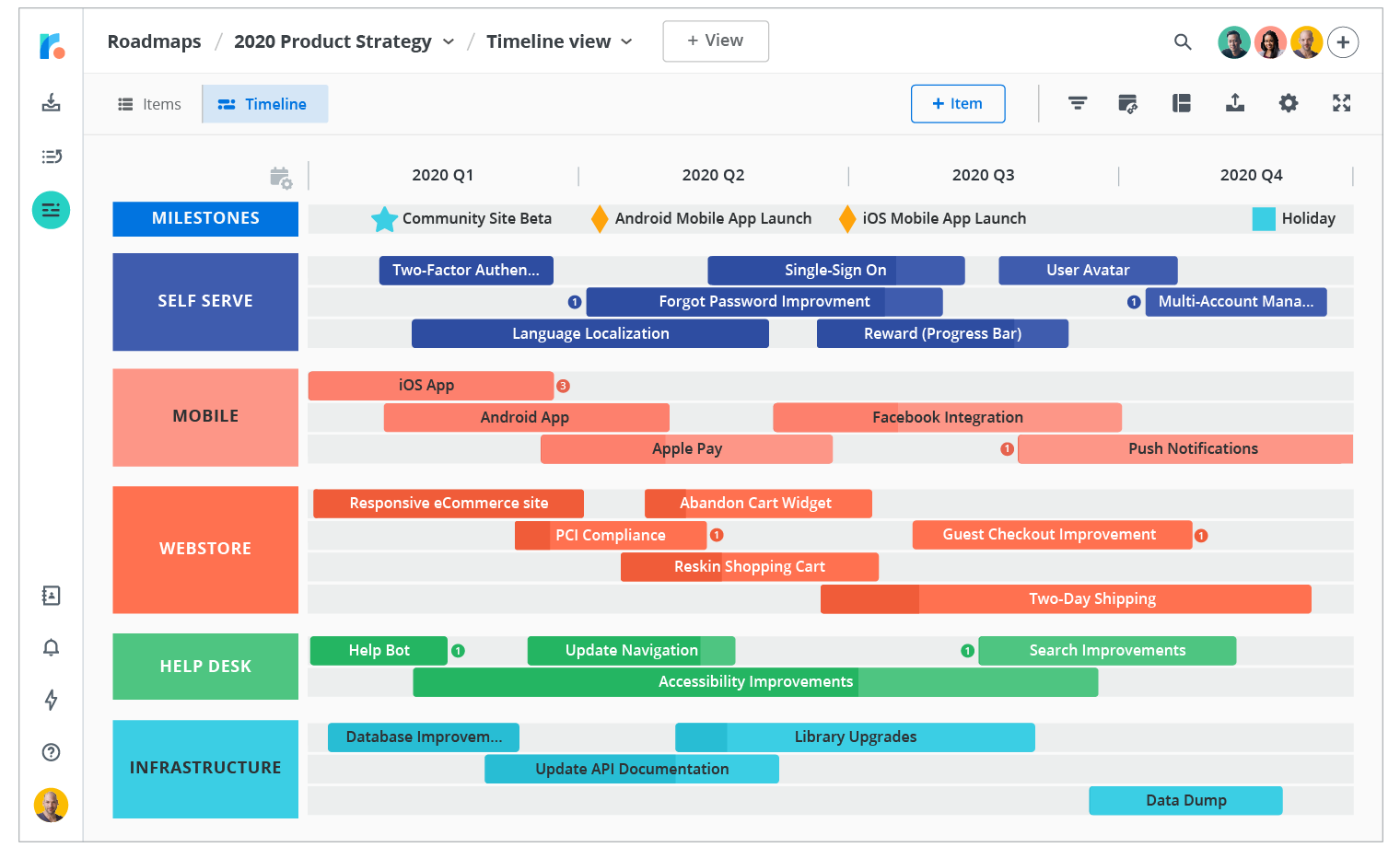
What is a product roadmap?
A product roadmap is a visual communication tool that aligns a company around a high-level product strategy. Depending on the type of organization, product roadmaps can include upcoming features and technical considerations, and often demonstrate how a product will evolve over time. Roadmaps communicate the intention of what customer and business outcomes a plan will achieve within a period of time.
A product roadmap is also a coordination tool: It gives stakeholders and team members the information they need to focus on their goals and priorities. Roadmaps bring visibility to all the moving pieces that help product teams coordinate their efforts, like scope and resource allocation, and the reasons behind those decisions.

Why are product roadmaps important?
When product managers establish a healthy product roadmapping process and culture at their organization, it helps achieve a few things:
1. Alignment and excitement around a product strategy
A product roadmap is the perfect tool if you want to create product strategy literacy across your organization.
2. Visibility into what is happening, changing, or progressing within the strategy
A great product roadmap creates stakeholder confidence in company progress.
3. Cross-functional team collaboration and clarity around priorities
Having a product roadmap encourages teams to narrow down the focus of the problems that can be solved using the available resources―a prioritization exercise in and of itself.
4. Ongoing communication
These ongoing conversations―about the why, how and who of the work to be done―create a culture of alignment and deep understanding of the vision and direction for the product.
How to plan what goes in the roadmap
1. Generate goal(s) for a specific, narrow period of time
Product managers rarely know what’s going to happen a year from now (market changes, discovery of new user needs, etc.), so planning for a one-year timeline doesn’t make sense. You only need the details of the who, what and how for the month and quarter, focused on working towards achieving a high-level goal or two (for agile teams and startups, even that time frame can be a stretch!).
How do you determine what the product goals for a quarter should be? No matter where you’re at in your company’s lifecycle—whether you’re a scrappy 20-person startup or a 2,000-person multi-product portfolio enterprise—it all starts with the product vision. It’s what Roman Pichler calls: "The reason for creating the product." Everything you do should be aligned with that unique positioning for your product.
2. Identify the problems that can be solved
Once you know your business goals and have a product strategy rooted in measuring and improving metrics related to those goals, it’s time to move into the problem discovery phase.
What user problems can you solve in order to impact those metrics you defined? Look for the problems that will create the biggest impact on the business goals.
- Customer feedback: Talk to your users frequently. We can't repeat this enough! Feature requests coming from sales and CS/CX messages are useful, but a product manager needs to be deeply embedded in user conversations. Look for the problems that can be potentially solved within the block of time you’ve defined for the roadmap.
Pro tip?: Use a model like Ash Maurya’s lean canvas) or the Jobs to be done frameworkto conceptualize and segment your understanding of customer problems and needs.
-
Usage data: How are your users interacting with your product and features? Look for the problems, barriers, and common trends in the behavior that can be potentially solved for.
-
Product competitive analysis: Experiencing your competitors’ products helps you gain a more comprehensive frame of reference for where your product stands in the market. Do a deep analysis, measure the experiences, and benchmark them against your product.
This depth of research and problem discovery during the product roadmap planning phase is crucial to targeting the right problems you’ll commit to solving over a period of time. This research is the evidence you’ll use to justify why certain features and initiatives should be on the roadmap during alignment discussions.
3. Align with your internal teams and stakeholders
Your product roadmap planning needs to be collaborative from start to finish.
Customer facing teams are key touchpoints for product managers during the product roadmap planning process. More than 70% of the Pragmatic Institute’s 2019 survey respondents said that they spend fewer than five hours a month processing customer feedback, and most product managers don’t have time to do ongoing, comprehensive user research.
How can you build relationships with your teams during the product roadmap planning phase? Have ongoing conversations with customers and customer-facing teams and be curious about their input on proposed solutions.
Lead your customer-facing team conversations with questions like:
- What problems do you feel are urgent? Can you walk me through why you feel that way?
- What evidence are you basing that on?
- What do you think is the impact of acting on/not acting on this piece of feedback?
4. Define metrics of success and KPIs for the initiatives in the product roadmap
What’s the best way to quantify the impact of the goals to be reached and problems to be solved within a period of time? Ensure that your roadmap is connected to well-defined key performance indicators (KPIs). Your roadmap should illustrate, or be informed, by the answers to the questions:
- What will our long-term impact be?
- How will we measure if this impact has been achieved?
- What’s the process for updating and communicating the progress of this impact?
One popular method that helps product teams answer these questions is Objectives and Key Results (OKRs). OKRs are a great goal-setting framework because they take a high-level vision and break it into manageable objectives.
OKR objectives are time-bound and actionable, as well as inspirational. Key results, on the other hand, take the qualitative aspect of objectives and turn it into quantifiable milestones. For example:
Objective:
- Triple average weekly sessions on mobile by the end of February
Key Results:
- KR1: QA all mobile functions
- KR2: Improve loading time by 40%
- KR3: Add one new integration to the mobile version
5. Create priorities for the product roadmap
A prioritization framework comes in handy during the product roadmap planning phase. Start by asking the questions: What initiatives will create the most impact? What’s the most urgent thing that needs to be tackled? What’s our scope of resources (time, effort, technology)? Then, move toward quantifying those answers to make prioritization decisions.
Free book alert ⚠️. We wrote a whole book about the prioritization process and the best frameworks you can adapt to your organization's needs. Get it here.
There are two weighted-score methods we like:
RICE. RICE stands for Reach, Impact, Confidence and Effort. It’s a simple weighted score method for quantifying the potential value of features, project ideas and initiatives. A RICE score helps product managers quantify the estimated value of a feature or project idea so they’re easier to sort when it’s time to decide the order they should be worked on. Sean McBride, who co-developed RICE prioritization as a PM at Intercom, walked us through how to best use this (prioritization method).
Value vs Effort. A popular, easy-to-communicate way to prioritize ideas is to compare the value gained from an idea against the effort required to complete it. By using a standard ranking scale from one to five, product managers or teams can make decisions quickly and easily. Check out our breakdown of the factors that define value and effort.
You can use both RICE and value vs. effort as templates in Roadmunk to start surfacing high-impact ideas. Try it here.

How to build a product roadmap
Roadmap formats
Roadmap formats tend to fall in three categories.
The no-dates product roadmap: This offers more flexibility than roadmaps built on timelines. They’re helpful for companies whose priorities are constantly shifting. This is usually the case when your product is still in its earliest stages—when you’re processing new information frequently.
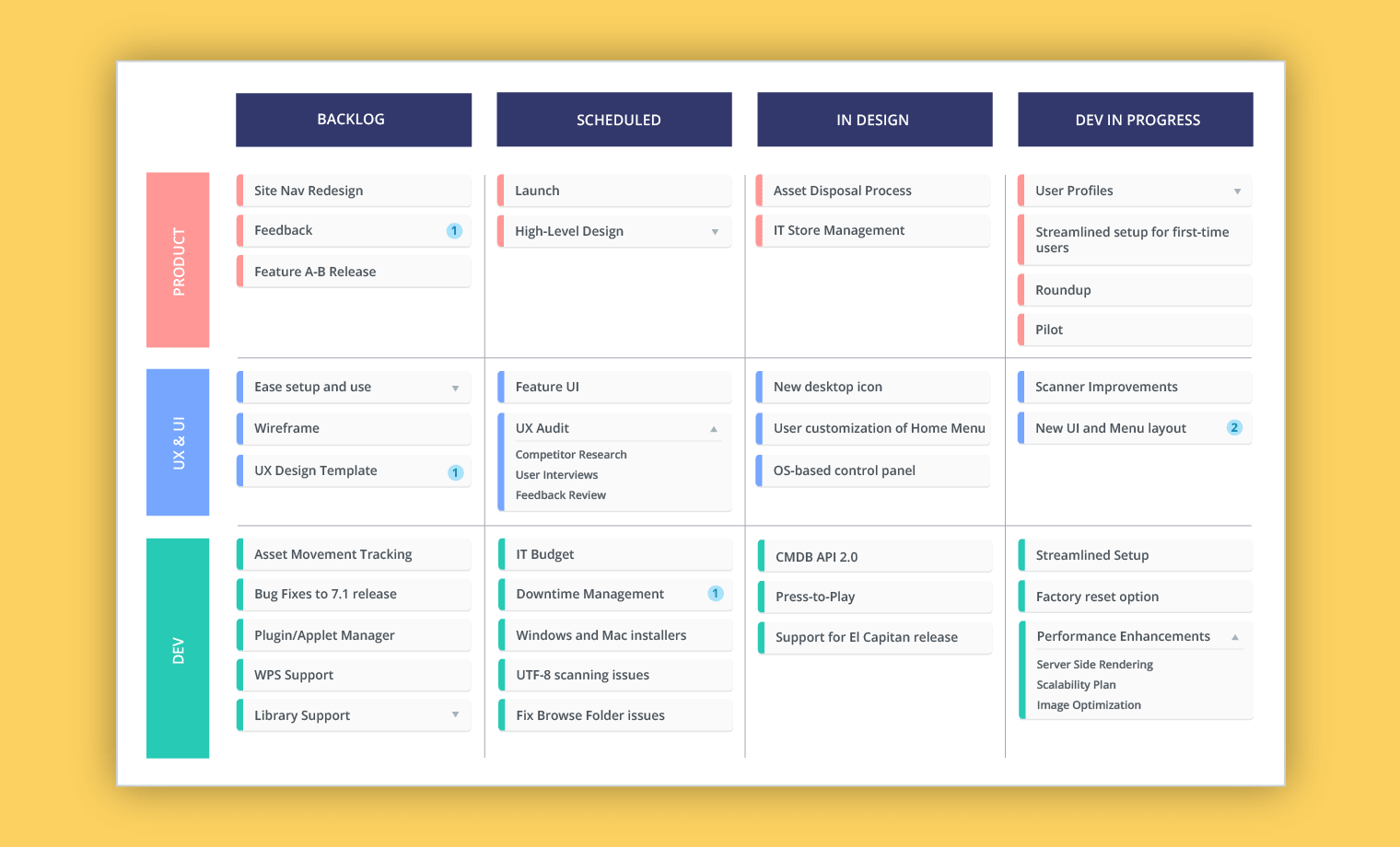
The hybrid product roadmap: This type of product roadmap includes dates—but not hard dates. For example, a company might create a product roadmap that is organized by month or quarter. This style of roadmap allows you to plan into the future while maintaining flexibility.
Items here are plotted by month, and designated as either Current, Near-Term, or Future. By time-boxing projects according to months, you create a loose projection that’s helpful but not constraining.

The timeline product roadmap: A complex timeline product roadmap really isn’t helpful or necessary until you’re juggling multiple departments, dependencies, and deadlines.
A timeline product roadmap gives a visual structure to the many moving parts that have to work together to ensure product success. They also show the product’s long-term vision—since some departments must plan a year or more in advance.
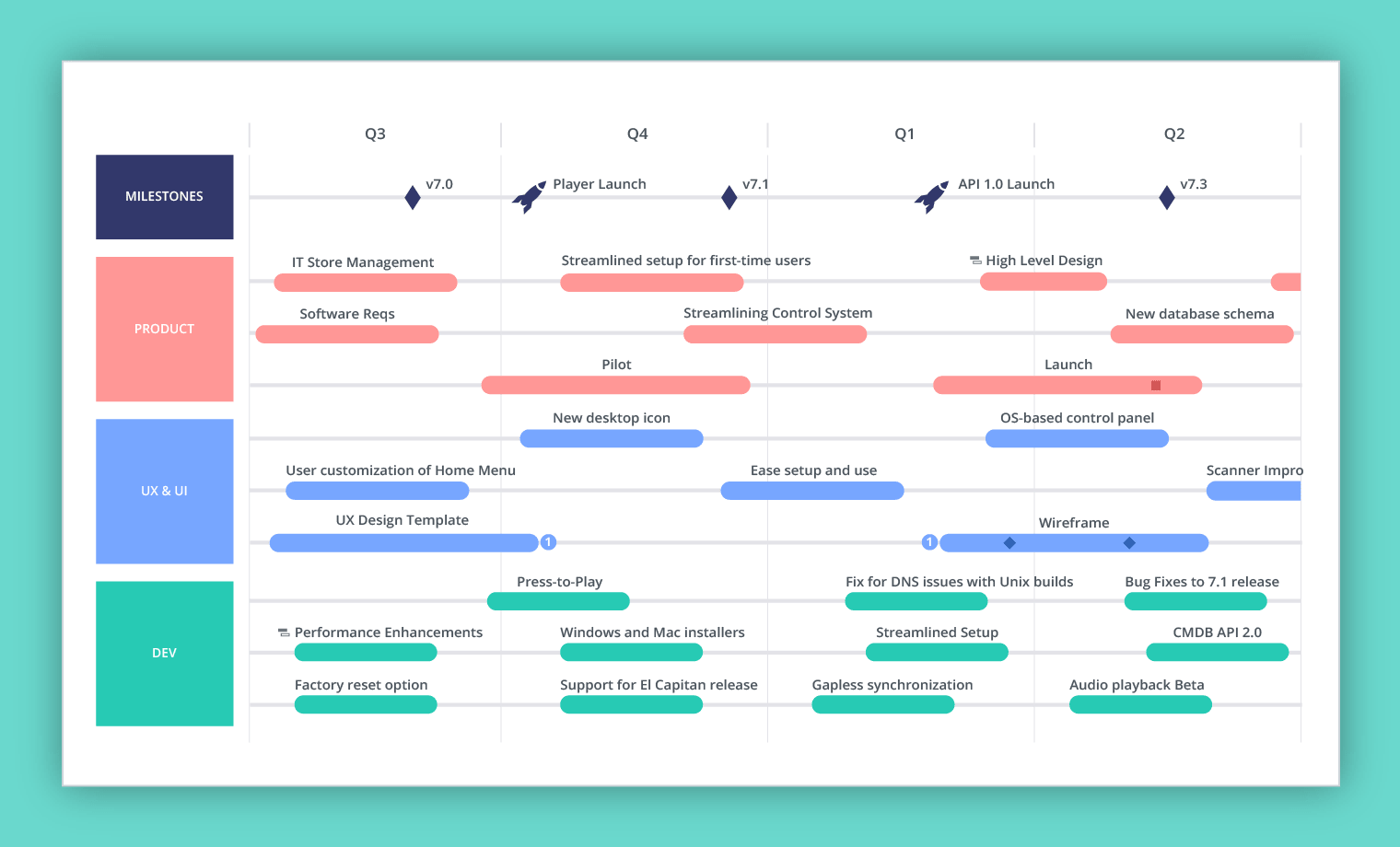
Along with working with a format that fits your company's needs, there are a few roadmap components that will make it a visual communication tool that your stakeholders can easily digest. (You can build a roadmap that includes all of these components using Roadmunk, by the way!):
- Identify dependencies early on. Every project, team, and initiative is related to one another, so it’s important to define those dependencies early on in the roadmapping process.

- Mark milestones. Having milestones can spotlight your organization's goals, major releases, events, and achievements, and visualizing a goal or key result on a roadmap helps your team rally behind it and understand what it takes to get there. This is especially useful if you’re using the OKR method.


How to present a product roadmap to get buy-in
Your roadmap presentation is the perfect time to shine as a product manager in front of your stakeholders: You’re able to demonstrate how well you know the market, the users, the product, and the business goals.
Before getting into a room with stakeholders, ask: What information does each department and stakeholder care about? What will affect their work the most?
Engineering
What they care about: Scalability, code, integrity of work, efficiency of work, and building features that add actual value (not just perceived value).
How to communicate your roadmap for successful buy-in: Engineering wants to understand the value versus effort. For developers, integrity is a top priority, and they’ll push back on features that seem difficult to scale or solutions that seem inelegant. You need to be able to explain the intrinsic value of each feature and milestone: value to the business, value to customers, value towards improving the product. Set realistic time frames (i.e., pad your estimates!), while striking a balance between urgency and limited resources.
What to show them: Focus on developer-oriented themes, like scalability, usability, quality, performance, infrastructure, and features. And keep it short-term!
Sales, CS and other customer-facing teams
What they care about: WHAT they can promise customers and WHEN those will be ready; building trust and loyalty; performance improvements for the product; ways to reduce churn.
How to communicate your roadmap for successful buy-in: Focus on the timeline. When will different outputs be ready? What can they promise customers and prospects now? Show how the roadmap will introduce ways to reduce churn and improve conversion. And go big: Highlight how the needs of large clients will be met, and how your roadmap creates opportunities for significant deals.
What to show them: The what and the when. Give them a transparent timeline they can communicate to customeThe “what” and the “when.” Give a transparent timeline they can communicate to customers and users. (Some schools of thought around roadmaps believe that you should keep dates out of the roadmap due to the risk of committing to something that might not be delivered. Assess that risk internally and decide if a dateless approach works best for you.)
CEO/Executive team
What they care about: The business goals and how the plan depicted by the roadmap will help the company achieve them. They want to see a strong connection between the development initiatives and the priorities of the business. Execs are more concerned with the investments a company is making (resource allocation) and how those investments will create a return.
How to communicate your roadmap for successful buy-in: CEOs think high-level and inter-departmental, so make sure your roadmap ties each initiative to customer value and business goals.
What to show them: The exec team will want to see what features you’re adding, but more importantly, they’ll want to see how the initiatives will help the product capture the market. They also want to understand any risks.
For a more in-depth look at how to present the roadmap to execs, check out this guide: Managing executives in the roadmapping process.
Customers (optional)
What they care about: If you decide to have a customer-facing roadmap, it’s important that they see the value your product will deliver.
What to show them: Customer-facing roadmaps should not include the “what,” “how” and “when” you’d show internal teams (so, no dates, documentation, or team capacity). Under-promise and over-deliver! Focus on the things they care about achieving, and define roadmap themes around those categories.
Suggested reading
How to ace your roadmap presentation

Product roadmap examples
Here’s a roadmap for visualizing your product strategy and getting your entire organization aligned. You can use this roadmap to chart how your product will grow over time.
The classic product roadmap example
Here’s a roadmap for visualizing your product strategy and getting your entire organization aligned. You can use this roadmap to chart how your product will grow over time and when.
Start using this product roadmap:

Agile product roadmap example
An agile roadmap illustrates how your product or technology will evolve—with a lot of flexibility. Unlike time-based roadmaps, which focus on dates and deadlines, agile roadmaps focus on themes and progress. Agile roadmaps encapsulate the flexibility of the agile philosophy: They’re a statement of where you’re going, not a hard-and-fast plan.
Start using this agile roadmap:
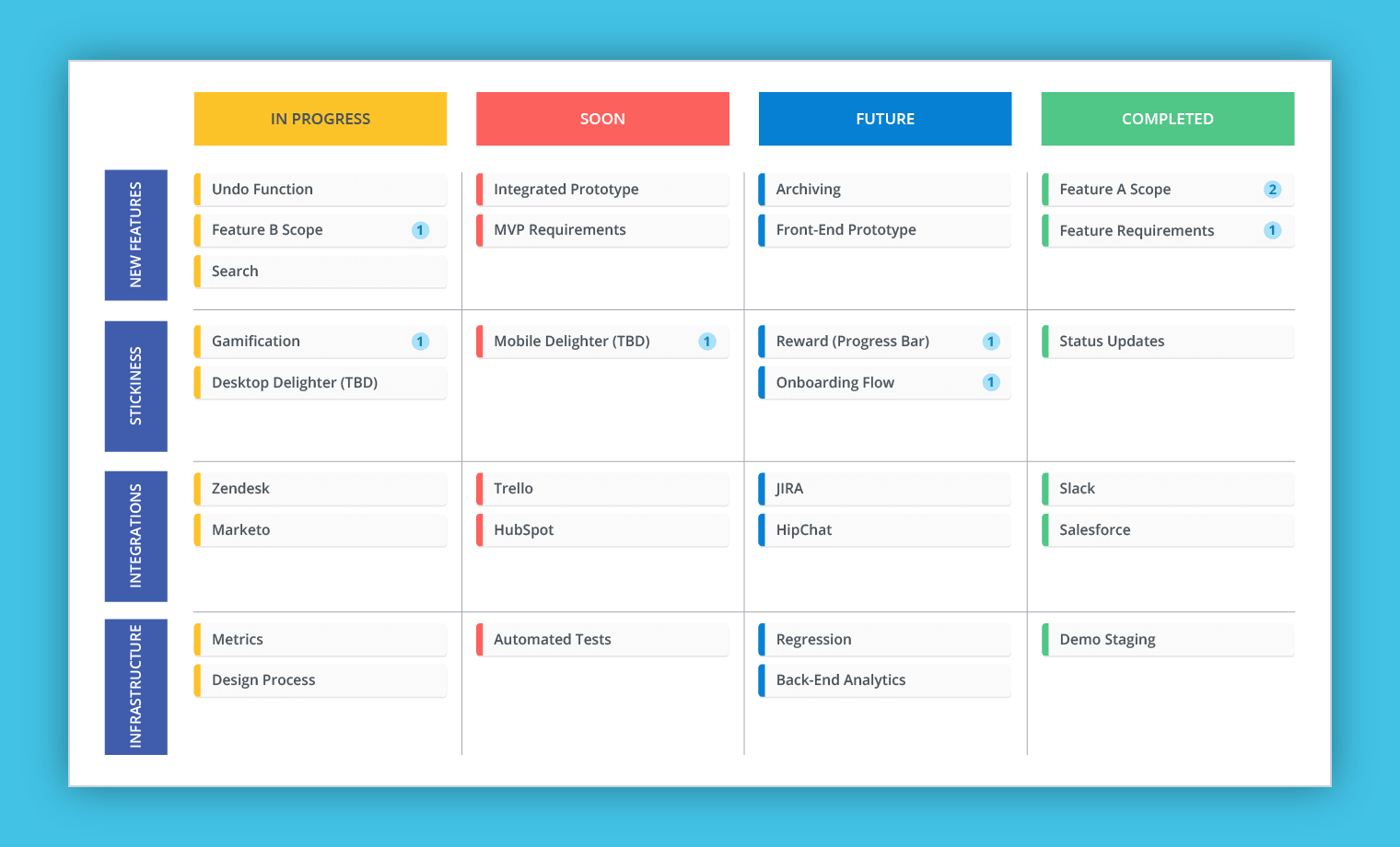
Feature roadmap example
Feature roadmaps track the development and releases of a product’s key features, communicating direction and progress.
Feature roadmaps manage an organization's resource allocation in development cycles and prioritize key releases. They keep focus on initiatives that add value for customers, without going into detail on other areas of a business.
Start using this feature roadmap:
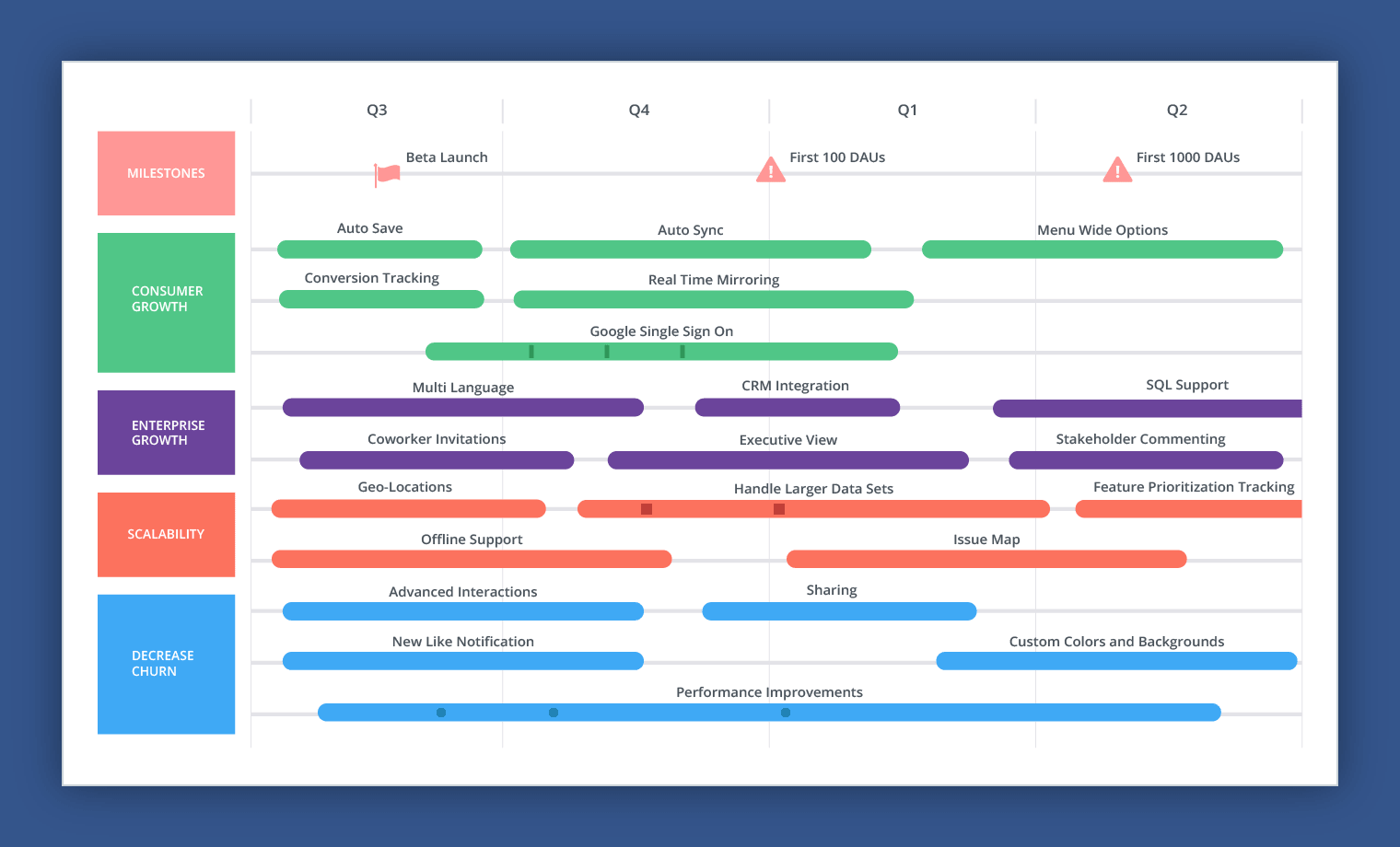
Product launch roadmap example
A product launch roadmap illustrates how a new product will hit the market. It crosses all teams involved—product, development, marketing, and sales. It outlines all tasks required to ensure pre-launch, launch, and post-launch tactics are successfully executed.
Start using this product launch roadmap:
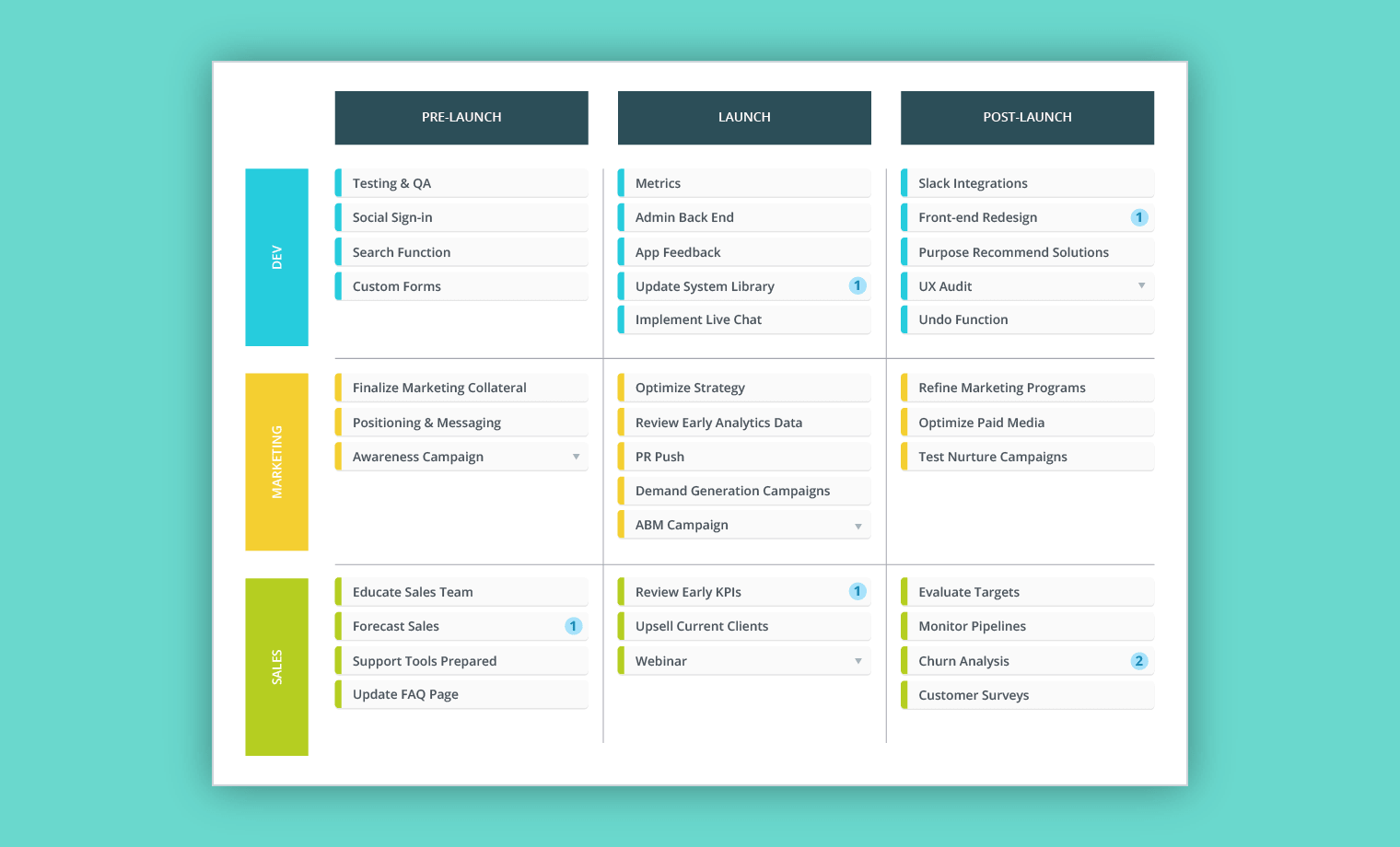
For more examples, visit our roadmap templates library. Choose from 45+ free templates and start using one with just a few clicks.
Final product roadmap best practices
It’s not a project management tool or a release plan. Ideally, your product roadmap doesn’t include the granular details of resource management and shipping dates. Your product roadmap focuses on what business and user outcomes it will create within a period of time (month, quarter, or year).
Keep your product roadmap flexible. Executive stakeholders want to know what’s going on over a number of quarters—sometimes even a year. But technology moves fast and different priorities emerge from ongoing conversations and product discovery interviews with users. Also, development timelines are often unpredictable; when you present your roadmap, you have to communicate how change is part of the development process.
Measure performance and share status updates. Roadmaps can’t be static documents like Excel and PowerPoint roadmaps. The roadmapping “lifecycle” doesn’t simply end with a presentation. You need to follow up on KPIs and progress, as well as keep your customers informed.
There are countless ways you can bring a roadmap to life. Sign up for a 14-day free trial and build your first product roadmap with just a few clicks.
Suggested reading
Product roadmap best practices by product managers
5 common questions about the roadmap
8+ free customizable product roadmap templates
How to focus on the right qualitative and quantitative data for the product roadmap
Why a roadmap tool is better than a Microsoft Office roadmap
